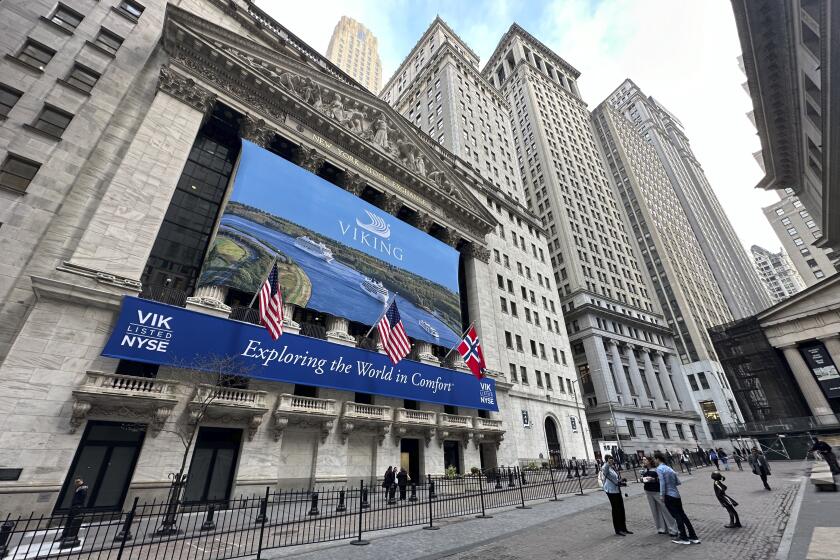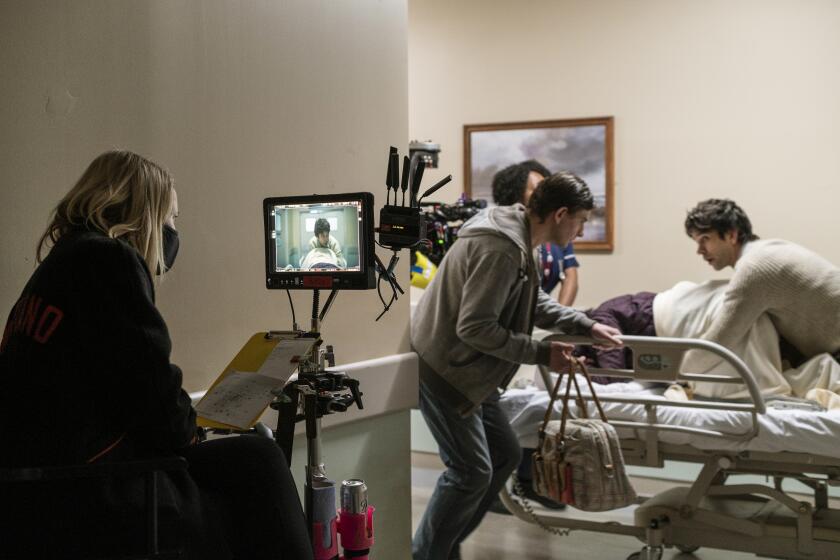As gold soars, Bodie is stirring
On a day when the price of gold soared above $1,700 an ounce, Jack Shipley drove past tourists strolling through this historic Eastern Sierra mining camp and up a rutted road to where a new breed of prospectors have set their sights.
The Bodie Hills hug the California-Nevada line in Mono County -- thousands of acres of jagged volcanic summits, thick sagebrush, dry lakes and plunging canyons lined with aspens.
The hills are a paradox: Empty and wild yet shot through with hundreds of untapped mining claims dating to the 19th century.
“I fell in love with this place the first time I saw it,” said Shipley, 66, who lived in Bodie, a ghost town turned state park, for a dozen years as its resident ranger. “But some of the most beautiful places here happen to be in the most concentrated mining zones.”
A bumpy 10 miles west of Bodie, Shipley stops at such a place -- one he wishes would be left to heal. The Paramount Mine yielded mercury for two decades, the last big haul in the Bodie Hills.
Left behind are rusted oil drums and pipes, piles of wood and a spooky open pit -- signs of abandonment that belie the vast gold deposits some believe remain underground.
With gold prices up more than 600% in the last decade, corporate prospectors are revisiting dormant mines worldwide: a South Carolina mine that funded the Confederacy; abandoned mines in the hills of Transylvania; Roman mines that haven’t been active for 2,000 years.
Among the seekers is Thomas Kaplan, a New York billionaire who’s a paradox himself, a shrewd commodities investor with gold mining ventures on five continents and co-founder of a conservation group that seeks to preserve big cat habitat in China and India, among other countries.
“If I’m given a choice between conservation and business, conservation wins, always,” Kaplan, an Oxford-educated historian, told Bloomberg BusinessWeek last year. He once spent $12 million to relocate a Bolivian village -- its people, buildings, church, cemetery -- to make way for a silver mine.
One of Kaplan’s companies, Cougar Gold, is eyeing the Paramount claims in the Bodie Hills, a mix of private and federal land. The interest has reignited a debate in Mono County over whether this raw swath of high desert is more valuable as protected wilderness than as a source of mineral wealth.
The split can be seen in the county seat of Bridgeport, whose fortunes have been tied to the area’s mining camps for 150 years.
Some in town see today’s gold rush as a lifeline to good-paying jobs. Others sense a rerun of the past when the boom times were relatively brief, the bad times drawn out and the environmental damage lasting.
“There’s a reason Bodie is a ghost town. Mining is a boom-and-bust industry,” said Stacy Corless, executive director of the conservation group Friends of the Inyo. “There’s still pollution up there left behind from mining 100 years ago. I’m worried about the legacy that’s left to future generations when this boom goes bust.”
On a day when the price of gold topped $1,800 an ounce, Cheryl and Lee McCoy were working like squirrels gathering nuts for winter.
Their fast-food joint, the Burger Barn, does a brisk business during summer and early fall, when Bridgeport stirs with fishermen, hunters, touring motorcyclists and Europeans looking for remnants of the Old West.
“I work seven days a week, 13 hours a day,” Cheryl McCoy said. “Just about everyone here works two jobs in the summer because there’s no jobs in the winter.”
McCoy has been too busy to figure out where she stands on mining in the Bodie Hills, but plenty of others have opinions.
Mining opponents argue that Bridgeport, with its Bierstadtian backdrop in a lush valley at the foot of the Sierra, should market itself as a paradise for snowmobilers and cross-country skiing and let year-round tourism boost the economy.
But there’s a hurdle: The two twisting mountain highways that link this area to the population centers on the western side of the Sierra close in winter. Off the beaten path in summer, Bridgeport practically becomes the frontier in winter.
Bob Peters, who owns the Bridgeport Inn and supports Cougar Gold’s mining proposal, sighs when asked his winter occupancy rate. “Zero -- because I close,” he said. “We tried keeping it open a couple of years, but I couldn’t make enough to meet the utility bills.”
Gold created this town. The Mono County Courthouse -- a magnificent two-story Victorian with gingerbread trim -- opened in 1880 during Bodie’s gold and silver boom. A plaque commemorates the first case heard, that of a man named Morton indicted on a charge of stealing gold bullion.
But within a few years the boom was a distant echo. By the 1930s, a writer for the federal Works Progress Administration described Bridgeport’s “dilapidated, partly crushed houses, long since abandoned.”
Today, Bridgeport lingers on the life support of seasonal tourism. Shuttered business line the main drag. The courthouse is an anachronism; most of its business has moved to a new court building in Mammoth Lakes.
Most days, there’s more going on in the ghost town of Bodie than in the living town of Bridgeport.
“Bridgeport is slowly drying up,” said Mono County Supervisor Tim Hansen, an outspoken proponent of Cougar Gold’s plan, which he believes will create jobs. “I have nothing against true wilderness
Hansen, 63, chain-smokes hand-rolled cigarettes and dismisses opponents from the Sierra Club and The Wilderness Society as “dried-up weirdos.”
“All these people who bought Priuses need minerals to make their batteries, right?”
Hansen harvests brine shrimp from saline Mono Lake, which he sells as commercial aquatic feed. When the recession hit, his business dived and Hansen went on unemployment. Then he landed a temporary laborer’s job with Cougar Gold, one of 17 locals hired in 2009 when the company spent several million dollars to test-drill in the Bodie Hills.
“Typically, I’m kind of leery about guys in suits,” Hansen said. “But when they offer you a job with reasonable pay and lots of overtime --”
Both sides in the debate frame the issue as one of local control. But it’s much more than that.
The Bodie Hills offer a window on a tug-of-war over millions of acres nationwide that are protected as wilderness study areas, public lands whose relative ecological and economic value has been argued for years.
A bill in Congress would strip wilderness study area status from areas that have been found unsuitable for permanent protection, including some 16,000 acres of the Bodie Hills.
More than 20 years ago, a Bureau of Land Management study noted the area’s beauty and its importance as threatened habitat for the greater sage-grouse. But it concluded that the Bodie Hills couldn’t be managed as wilderness because of hundreds of valid mining claims.
Interior Secretary Ken Salazar is pushing for legislation that would identify “crown jewel” lands worthy of wilderness designation. Environmental groups want the Bodie Hills to be included, which wouldn’t preclude mining but would make it practically impossible.
Political battles over wilderness are complex and move with the swiftness of a tortoise. Though Mono County’s elected leaders will decide none of this, both Cougar Gold and environmentalists have sought support from the Board of Supervisors as a lobbying tool in Congress.
When the company presented its case to the supervisors at a packed meeting in February, it sent a big cat to town.
Mark D. Wallace is chief executive of Tigris Financial, Cougar Gold’s parent company. He’s a lawyer, former U.N. diplomat and GOP strategist who worked for George W. Bush during the 2000 Florida recount and was Bush’s deputy campaign director in 2004.
Wallace’s message to Mono County was direct: Cougar Gold won’t spend any more money exploring an area that could be designated as wilderness.
“A lot of us are quite fond of the people there. This could be a real success story,” Wallace said in an interview. “The community needs to make a decision. We’re good with whatever it is.... There are other places to work.”
From Rome to Cortez to a bankrupt Bodie, the hunt for gold has always been an unforgiving business.
Gold is used in electronics and dentistry, among other fields. But its value isn’t based on its usefulness as an industrial mineral.
The vast majority of what’s mined is made into jewelry, bars and coins.
“It gets dug out of the ground ... then we melt it down, dig another hole, bury it again and pay people to stand around guarding it,” billionaire investor Warren Buffett said during a talk at Harvard University in 1998. “It has no utility. Anyone watching from Mars would be scratching their head.”
Here on Earth, it is precious, rare and enduring.
That’s the case for gold. And for wilderness too.






